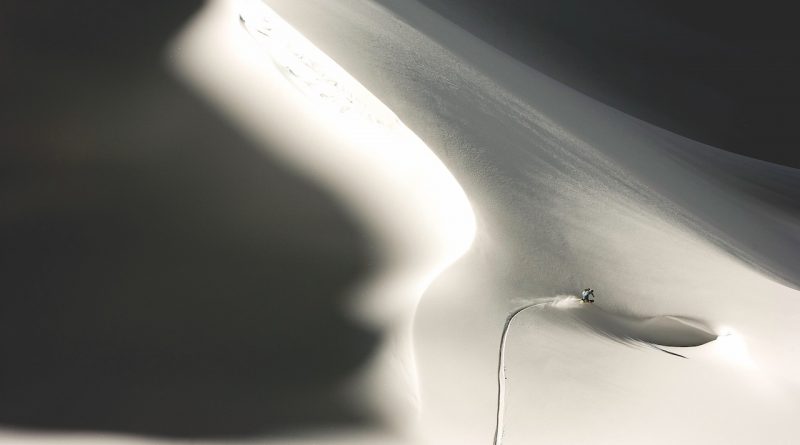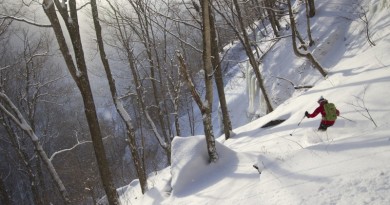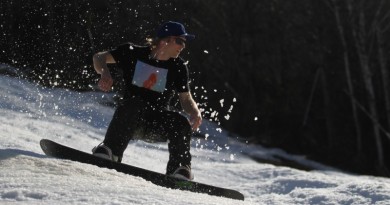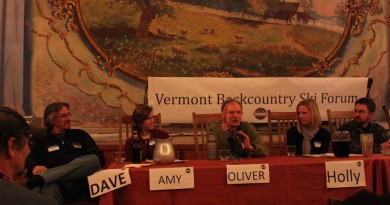The 7th Life Of Jake Burton Carpenter
Eds. note and update, Nov. 21, 2019: It is with great sadness that we report that Jake Burton Carpenter, a friend, neighbor and leader, passed away on Wednesday, Nov. 20, 2019 surrounded by family and friends. On Nov. 9, Jake sent the following email to his employees:
“You will not believe this, but my cancer has come back. It’s the same tumor as the first time around. We just never got rid of it all. A bit of it hung out in my lymph nodes and got back into business. The odds are in my favor, but it is going to be a struggle for sure.As much as I dread what is facing me, it’s easier to deal with when you know that you have a family that will carry on.I feel the same way about my company, my friends and our sport. I will be back, but regardless, everything is in good hands which is an amazing feeling when entering this zone of uncertainty.—Jake
Below is our feature profile from 2017 based on interviews with him and Donna on the 40th anniversary of Burton.
Let me show you in a figure how far nature is enlightened or unenlightened: Behold, human beings living in an underground den, which has a mouth open towards the light…” – Plato, Allegory of the Cave, The Republic
Tuesday in early January, there’s a slight drizzle. Snowboarding’s most famous couple is at the base of Stowe Mountain Resort, razzing each other about who picked up whom on New Year’s Eve, 1982, at the Mill in Londonderry.
“My name is Jake and I build snowboards. That was his pick-up line,” says Donna Carpenter as she unstraps from her board. She stretches out his name, ‘Jaake,’ the way actor Jeff Bridges in the film, “The Big Lebowski,” says “I’m the Duude.”
“So, I’m this cool girl from New York City and wanted nothing to do with him,” says Donna, with a laugh. Jake Burton Carpenter shakes his head and steps out of the new Step-On prototype bindings.
“No way, you picked me up,” he says.
She was 18. He was 28 and making snowboards in a barn.
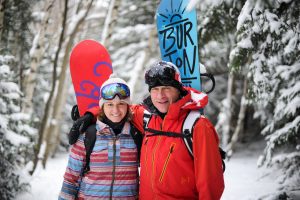
Thirty-five years later, they are married with three kids. Donna is the CEO of Burton, (the “CE-Ho” Jake calls her). It is a global company now with a 35 percent share of the snowboard market, five offices around the world, and retail outlets from Haight-Ashbury to Soho. They own sub-brands, Anon, Red, Channel Islands surfboards and more.
The company is still headquartered in Burlington, Vt. It celebrates its 40th year this year (see Burton: 40 Years of Innovation) and is about to come out with the Step-On binding, a breakthrough product it’s been developing for four years.
Donna and Jake are healthy and, at 53 and 62, remarkably fit. They live in a relatively modest farmhouse in Moscow, Vt., albeit a farmhouse with a basement you can skateboard in. They ride 100 days a year.
This all seems slightly miraculous on any number of levels—not the least of which is that Jake Burton Carpenter is still alive.
THE DARK
“How could they see anything but the shadows if they were never allowed to move their heads?” —Plato, The Republic.
“The last 18 months have been pure hell,” says Donna on the chairlift ride up. We’ve done a few runs on buttery-soft snow, Jake pulling ahead. “I’m not as fast as I was,” he says. “I used to be able to do really short, quick turns—that was my thing. But I’m getting stronger. Last year I had a hard time keeping up with Donna.”
In January 2015, Jake had a full knee replacement. In March 2015, he went to the U.S. Open in Vail and snuck in turns with his son George, pro rider Kevin Pearce and his surgeon and friend Bryan Huber.
The next week, Jake was back in Stowe and swimming. A strong surfer and a captain of his college swim team at New York University, he regularly swims intervals at The Swimming Hole. “I was in the pool when I began seeing double,” he says.
“I thought he’d just been partying too much and blew it off at first,” Donna remembers. The next day, Jake went to Copley Hospital in Morrisville. “They were great, did all the tests. Then they told me, ‘This isn’t something we can handle: you need to go to Dartmouth Hitchcock.’”
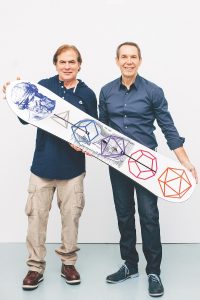
“When I got to Dartmouth, I heard: ‘Tomorrow you won’t be able to swallow. The next day, you won’t be able open your eyes. The day after, you won’t be able to breathe,’” Jake recalls. He would be placed on a feeding tube and would need a tracheotomy to breathe.
Jake was diagnosed with Miller-Fisher syndrome, a nerve disease related to Guillain-Barre syndrome that causes the auto-immune system to fight first the sheath of the nerves and then the nerves themselves. If caught soon enough and treated, the resulting paralysis is temporary and treatable. “If it gets to the nerves, not just the sheaths, it can mean three years before you recover, not three months,” says Donna.
As Jake lay flat, able only to communicate by scribbling notes on a pad, his mind went to a very dark place. “I wrote notes to my kids that I was thinking about suicide,” he says softly. “ I was lying on my back unable to move or speak or breathe. Miller-Fisher really messes with your mind and impacts your brain. I didn’t know how out of it I was and I just didn’t believe I would ever get better.”
It was not Jake’s first brush with a serious illness. In 2011 he was diagnosed with testicular cancer. He went to the Mayo Clinic and went through four rounds of chemotherapy. His oldest son, George, came out to help. “That time really brought us closer together,” Jake says.
“If Jake has nine lives, he’s on about number seven,” says Donna.
In July, Jake was well enough to move home where Donna began to care for him, while still running the company. His feeding tube was not removed until August 19.
Six days later, Burton was being flamed across the internet. Yo-Beat, a website that bills itself as “making fun of snowboarding since 1977” (the year Burton was founded) published an anonymous letter alleging that two of Burton’s key management team were using drugs on the job, alienating employees, mismanaging funds and leading the company away from the core snowboard culture it had built. It prompted Vice to run the headline “Is Burton in Trouble?”
Then, on Christmas eve, 2015, two of the Carpenters’ sons headed up to the Stone Hut, the state-owned, off-the-grid cabin near the summit in Stowe. The family has spent many Christmases there, but that day the boys headed up to stoke the fire for friends who were supposed to arrive later that day. To get the fire going, they left the door of the wood stove open and a wet log leaning against it. The next morning, ski patrol found the hut engulfed in flames. The Carpenters donated $150,000 towards its rebuild.
The rest of the season it barely snowed on the East Coast or in Europe, two of Burton’s biggest markets. In March, 2016, Burton announced layoffs.
THE LIGHT
“Anyone who has common sense will remember that the bewilderments of the eyes are of two kinds and arise from two causes: either from coming out of the light or from going into the light.” — Plato, The Republic
During Jake’s illness, a steady stream of Burton pro riders, including Mark McMorris, Danny Davis and Shaun White, made pilgrimages to the hospital room. “It’s those guys who keep the passion going and keep me stoked,” says Jake. “It’s those guys and girls who inspire me.”
In the early days of snowboarding, Burton fought hard to wrest pro rider Craig Kelly away from Burton’s biggest early competitor, Sims. He won. Kelly rode for Burton for more than 20 years before he was killed in an avalanche in 2003. Since then Burton has signed—and helped make—the biggest names in the sport: including Terje Haakonsen, Jeff Brushie, Kelly Clark and Mikkel Bang. (It also supported emerging riders like Ralph Kucharek, 24, from Burlington, who is on the cover of this issue riding Burton’s unbranded board, Knowbuddy.)
“Like us, these guys are passionate about snowboarding,” says Jake. “Shaun White would snowboard even if he never got paid a dime because he loves it.”
“Passion is what it is all about,” Donna agrees. “When we were starting out, we looked at the ski industry and realized those guys had lost their passion: the ski companies were getting bought out by big companies. They were being run by guys in suits and hosting their meetings at golf courses,” says Donna. “That’s why we give employees lift tickets and have our meetings on snow.”

Snowboarding revolutionized winter sports. But as with skiing, it has seen a decline in recent years, going from 8.2 million in 2010-11 to 7.7 million in 2014-15, according to Snowsports Industry of America. “We certainly thought about selling the company,” Jake admits. “But the best thing we’ve done is keeping it private. If we had gone public, I would have been fired long ago.”
“Staying private has meant we can think long-term and not make those decisions that might be good short-term solutions but harm the company down the road,” says Donna. “For instance, I’d say our number one innovation now is a focus on sustainability.”
In the last year, the company has managed to save 60 percent to 85 percent of the waste from producing a board by upcycling it into things like name tags or sample holders for breweries and 80 percent of its apparel is bluesign approved, an environmental standard for textiles.
One of the things Burton has focused on is consistently innovating and putting out new product but not oversaturating the market—a problem, Jake notes, that has become rampant in the ski industry. “Who wants to see some guy show up with the same board as you but he bought it this year at 30 percent off?”
It has also grown through expanding its outerwear and durable goods line to include backpacks and even tents. Much of the expansion has been done through co-branding collaborations, which this year include South Park, Star Wars and outdoor tent company Big Agnes— “everything from Disney to Playboy,” says Donna.
The latter collaboration earned the company some heat, especially as Donna was trying to play a larger role in getting women on boards. “At first, I was like, no way are we doing a Playboy board,” she says. “But then I saw the graphics, and they were more kitschy, and sort of 1950s style – not really porn. Now, not even Playboy is showing full nudes so the collaboration seems pretty benign.”
On this rainy day, Donna is wearing a long jacket with logo patches. It is part of the LAMB line, a collaboration with Gwen Stefani. Jake, who tests every piece of new men’s apparel, has a black, microfiber button-down shirt from next year’s line and a retro pull-over shell that looks a lot like the first Powder Shell he launched in 1984. With a helmet and goggles on, you might never recognize the godfather of snowboarding until you look at his bindings: they have no straps.
THE FUTURE
When it came time to build an R&D facility in Burlington, the Carpenters named the 10,000-square-foot space “Craig’s,” in memory of Craig Kelly. While you can tour much of Craig’s and see boards being built, parts of it are hidden from view. There, over the past four years, engineers have been secretly working on the “Step-On” binding.
“You told the guys, ‘Hey, I’m 60 years old, I’m tired of sitting on my ass in the snow and strapping in,’” Donna says to Jake. While step-in bindings have been around for two decades, the challenge has been to create one that doesn’t jam with snow. “This binding has three clicks to it, so you can click in lightly and then, as the snow melts, you stomp down harder and click in more,” says Jake.
The binding and the accompanying boots come in two stiffnesses and two models for both men and women. They will come on the market next fall. “It’s going to be a game changer,” says Jake. “It’s probably the third biggest innovation I’ve seen in snowboarding, after metal edges and the high-back binding.”
Craig’s is also where Jake built his first and only signature board, The Stone Hut, the limited-edition board he named for the cabin atop Stowe. And it’s where he worked on the shape and design board he is riding now, The Philosopher, with graphics by artist Jeff Koons.
“I thought I was a control freak, you should see Jeff at work,” Jake says of Koons, the contemporary artist whose orange Balloon Dog, sold at auction for a record $58.4 million. Koons fell in love with snowboarding and came to Burton two years ago for a collaboration.
“When you’re on a snowboard, there is a sense of oneness, and I’m just mesmerized by it. So, I created an idea for a board that reflects the philosophy of this feeling, starting with Plato’s Cave – the idea of transcendence, freeing oneself and walking out of that cave in a higher state of consciousness. That’s what the act of snowboarding does for me,” Koons told Britain’s The Telegraph.
Koons wanted the graphics to be reflective so Burton created the largest foil stamps ever used. Only 50 boards were made, each priced at $5,000. They were sold to raise money for The Chill Foundation, which the Carpenters launched to introduce underprivileged kids to snowboarding.
The allegory of the cave tells the story of prisoners who are tied up in a cave and can see only shadows of the real world that are projected on the walls from the outer world. It’s only once they emerge from the cave that they see things as they are.
After a year of hell, Jake and Donna are beginning to see light ahead. “One thing this past year has done is it helped me really rely on John Lacy, our president. He’s my retirement strategy,” says Donna. Their oldest son George (whose middle name is also Burton) now plays a role in the business too.
“We told all of our kids they had to do three things before they could join the business: they had to work somewhere else, they had to learn a foreign language and they had to do service work and volunteer. George has done all three and joined us as a product developer.”
The family spent Christmas in Utah where Timi, the youngest has been studying to get his backcountry guide certification. “If anything, this past year has brought us all closer together,” says Donna.
Jake nods and smiles. “Flying home from Utah I was thinking that if this plane went down right now I wouldn’t think I’d been shortchanged in any way. No, I have no regrets.”

